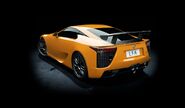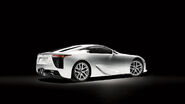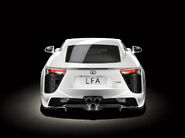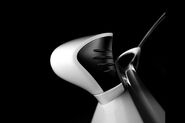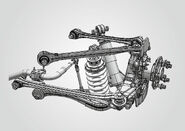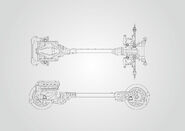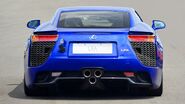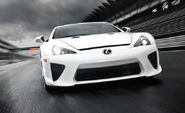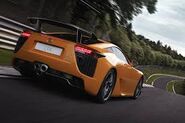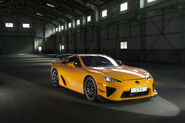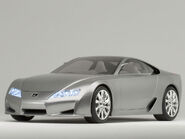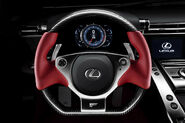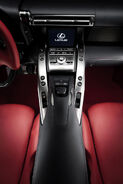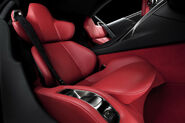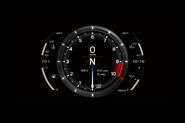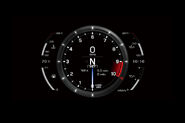
| |
| Lexus LFA | |
|---|---|
| Lexus | |
| aka | Lexus LF-A Concept |
| Production | December 2010- December 2012 500 units only (20 per month) |
| Class | Supercar |
| Body Style | 2-door, 2-seat Front-Mid engined Coupe |
| Length | 177.6 in (4.51 m) |
| Width | 74.8 in (1.90 m) |
| Height | 48.0 in (1.22 m) |
| Wheelbase | 102.56 in |
| Weight | 3263 lb (1480 kg) |
| Transmission | 6-speed Automated Sequential, RWD |
| Engine | 4.8 litre (4805 cc) 72º 1LR-GUE dual VVT-i DOHC V10, 40 valve |
| Power | 560 hp (412 kW/560 PS) @ 8700 rpm 354 lb-ft (480 Nm) of torque @ 6800 rpm |
| Similar | Ferrari 599 GTB Fiorano Lamborghini Murcielago LP670-4 SV Mercedes-Benz SLS AMG Chevrolet Corvette ZR1 McLaren MP4-12C |
| Designer | Haruhiko Tanahashi under Simon Humphries |
The Lexus LFA is a two-seat exotic sports coupe produced by Lexus as a concept car, racing prototype, and production vehicle.[1] It is the second model in the F marque line of performance vehicles from Lexus, following the IS F. Three concept versions have been shown, each debuting at the North American International Auto Show with the LF-A designation as part of the LF Series concept line. The first LF-A concept premiered in 2005, followed in 2007 by a second LF-A with a more completely furnished interior and exterior. The third version of the LF-A, a roadster model, premiered in 2008. The production model, trademarked LFA,[2] was shown at the Tokyo Motor Show in October 2009.[3]
The production Lexus LFA features a new V10 engine and a carbon fiber-reinforced polymer (CFRP) body. The use of CFRP materials, which account for 65 percent of the LFA's body composition,[4] is to reduce overall weight for improved performance. The LFA is scheduled to go into production in late 2010, with a projected run of 500 hand-built vehicles at an estimated base price of $US375,000. A circuit-tuned variant is scheduled for 2012.[5]. The LFA at one stage was the fourth fastest production car around Nurburgring and the fastest car ever around it not using competition tires. It also has the fastest wet lap track time at the Top Gear circuit [1]
Recent Changes[]
- On March 15, 2010, Lexus announced a limited edition version of the LFA dubbed as the LFA Nürburgring Special Edition. Available in a choice of Black, Matte Black, "Whitest White", or Orange, this car distinguishes itself by way of canards and a fixed wing in CFRP (carbon fiber reinforced polymer) and ECU work that ups the power output from 560 to 570 hp and reduces shift times from 0.2 to 0.15 seconds. It will also get grippier tires and a hardcore suspension. [2][3]
Styles and Major Options[]
Currently, the LFA Nürburgring Special Edition is the only special variant of the LFA.
Pricing[]
Add more fields as necessary.
| MODEL Trims | |
|---|---|
| LFA | LFA Nürburgring Special Edition |
| MSRP | |
| ¥ 37.5 million (US$ 375,000/€ 250,720) |
US$ 450,000 |
| Invoice | |
| $Price1 | $Price2 |
Gas Mileage[]
Add more fields as necessary.
As seen on the FuelEconomy.gov website, the City/Highway MPG averages are as follows:
| Trim | |
|---|---|
| LFA | LFA Nürburgring Special Edition |
| MPG | |
| 14/20 | c/h |
Engine and Transmission[]
Engine[]
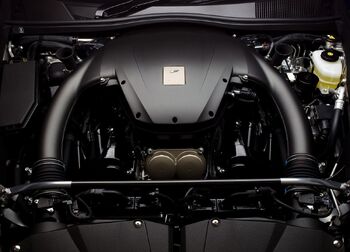

The LFA is powered by a 72° 4.8-liter V10 engine equipped with Dual VVT-i carrying the 1LR-GUE designation with a maximum output of 552 bhp delivered at 8700 rpm. Its maximum torque output of 354 lb-ft arrives at 6800 rpm, 90 percent of which is available from 3700 rpm. The engine, like the Ferrari 458 Italia, redlines at 9000 rpm and is constructed using forged aluminum pistons, titanium connecting rods, titanium valves and uses dry sump lubrication as well. Air is fed directly from beneath the hood through a large rectangular opening using a dual stage variable intake manifold into 10 individual throttle bodies and exits through a titanium muffler. Toyota attempted to design the engine to sound like that of a Formula One car with rapid revs and claims an analog tachometer needle would be unable to accurately track the LFA's rapid changes in engine speeds, necessitating the use of digital tach which can instantly display rpms.
The powerplant gives the LFA a power to weight ratio of 5.9 hp/lb and enables it to reach a top speed of around 202 mi/h.[6] Like the IS F Yamaha co-developed the engine cylinder heads. The engine complies with Euro V emissions. On the LF-A, the V10 is installed with a front mid-engine placement.
According to Chief Engineer Haruhiko Tanahashi a front engine layout was selected instead of a mid engine layout as it is inherently more forgiving dynamically affording less experienced drivers with a wider safety net.[7] To maintain a near ideal weight distribution, a rear transaxle is used, in addition to the mounting of the fuel tank ahead of the rear axle and the radiators at the rear. [8] The engine is connected to the transaxle via a rigid torque tube which the exhaust system runs directly below. This arrangement is designed to lower the vehicle's center of gravity compared to conventional designs.
- Engine Type: 1LR-GUE
- Cylinders/arrangement: V10
- Valve mechanism: 40-valve DOHC
- Displacement: 4,805 cc
- Bore x Stroke: 88.0 x 79.0 mm
- Compression ratio: 12.0:1
- Fuel Injection Type: EFI
- Octane Rating : 95 or higher
- Max. Power: 552 bhp @ 8,700 rpm
- Max Torque: 480 Nm @ 6,800 rpm
- Max. engine speed: 9,000 rpm
- Exhaust emissions certification: Euro 5
Transmission[]
The gearbox itself is a six-speed electrohydraulic transmission operated with paddle-shifters. The driver can select from four settings, auto, normal, sport and wet. Toyota quotes the sport mode's gear change times as ~200 ms. According to Tanahashi a twin-clutch transmission was tested but gear changes were found overly smooth, resembling that of a traditional automatic with its shock absorbing torque converter and the design team preferred the feel of more abrupt and courser shifts, however the auto mode and low speed performance suffers as a result.[9] A Torsen limited slip differential is also applied on the LFA.[3] The Lexus LFA transmission gear ratios are as follows:[10]
- Gearbox type: 6-speed Automated Sequential Gearbox
- Front counter gear ratio: 1.259
- Gear ratios
- 1st: 3.231
- 2nd: 2.188
- 3rd: 1.609
- 4th: 1.233
- 5th: 0.970
- 6th: 0.795
- Final drive ratio: 3.417
- Maximum permissible speed
- 1st: 52 mph
- 2nd: 76 mph
- 3rd: 104 mph
- 4th: 136 mph
- 5th: 172 mph
- 6th: -
Performance[]
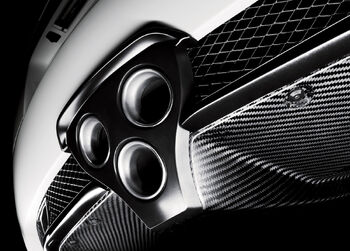
The exhaust pipes.
Performance[]
- 0-62 mph (0-100 km/h): 3.7 s
- Top speed of 201.94 mph (325 km/h)[11]
- Power-to-weight ratio of 5.8 pounds/hp
- 48/52 front-to-rear weight distribution
Brakes[]
- Front: Cross-drilled ventilated discs, 399 x 34 mm
- Rear: Cross-drilled ventilated discs, 360 x 28 mm
Suspension[]
- Front: Double wishbone with anti-roll bar
- Rear: Multilink with anti-roll bar
Steering[]
- Steering gear type: Rack and pinion
- Power steering type: Electric
- Ratio: 14.3
- Turns lock to lock: 2.35
Tyres and wheels[]
- Wheels
- Front: 20x9.5J BBS alloy
- Rear: 20x11.5J BBS alloy
- Tyres
- Front: 265/35R20 95Y
- Rear: 305/30R20 99Y
Reliability[]
Warranty options and scheduled maintenance information should be mentioned here.
Safety[]
The Lexus LFA is fitted with a Takata “Airbelt” system which is commercially known as the SRS Seat Belt Airbag.
The airbag is built into the webbing of the seat belt, which inflates on impact to provide additional protection to the shoulder and critical head area. The system is the first of its kind in the world for passenger cars, and provides additional protection in both frontal and side impacts through a single safety product.
In the case of a frontal impact, the belt expands directly to spread the shock-load over a wider area of the occupant’s chest. In a side impact, the belt inflates between the shoulder and head to reduce lateral head movement and provide protection from impact with the side window or colliding object.[4]
Other safety features[]
- 4-wheel ABS
- Dual front side-mounted airbags
- Emergency braking assist
- High pressure washers headlamps
- Xenon high intensity discharge headlamp
- 2 front headrests
- Front seatbelt pretensioners
- Stability control
- Traction control
- Electronic brakeforce distribution
- Front integrated headrests
- Tire pressure monitoring
Photos[]
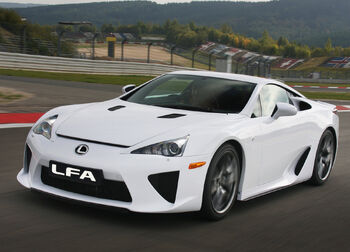
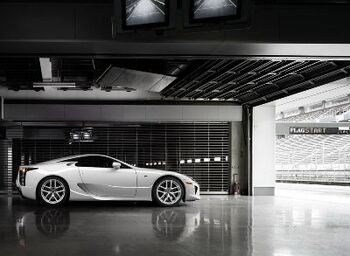
LFA[]
LFA Nürburgring Special Edition[]
2005 LFA Concept[]
Add Photos of the vehicle here.
Please make sure not to use copyrighted photos.
Colors[]
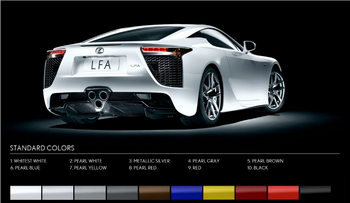
Lexus LFA Standard colors.
Standard[]
- Whitest White
- Metallic Silver
- Pearl Gray
- Pearl Brown
- Pearl Blue
- Pearl Yellow
- Pearl Red
- Red
- Black
Special[]

A chart listing the colors available to the LFA.
- Ivory White
- Mint Green
- Aqua
- Lavender
- Sky Blue
- Lime Green
- Fresh Green
- Orange
- Passionate Pink
- Sunset Orange
- Slate Blue
- Steel Blue
- Moss Green
- Crystal Gold
- Brown Stone
- Steel Gray
- Lapis Lazuli
- Black Amethyst
- Starlight Black
- Matte Black
Main Competitors[]
In terms of price, performance and exclusivity, these are the LFA's closest competitors. However, it should be noted that at its US$ 375,000 entry fee and 500 unit production, the LFA sits in a unique market segment that has no direct competitors (or which are no longer produced, such as the Porsche Carrera GT or the Mercedes-Benz SLR-McLaren).
- Ferrari 599 GTB Fiorano
- Lamborghini Murcielago LP670-4 SV
- Mercedes-Benz SLS AMG
- Chevrolet Corvette ZR1
- McLaren MP4-12C
Hybrid Models[]
There are no hybrid models for the LFA.
Unique Attributes[]
If there are any features of this vehicle that sets it apart from other vehicles in its class, then mention those unique attributes here.
Interior[]
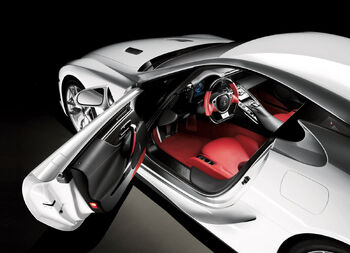
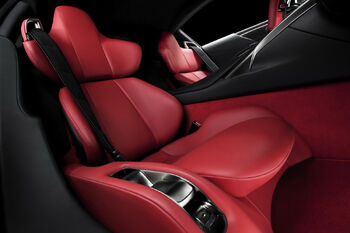
The LFA interior incorporates carbon fibre, leather, alcantara, and metallic surfaces. There are two bucket seats, and Lexus' Remote Touch controller interface. The interior design uses bespoke materials and colours. The instrument display is a digital thin-film transistor (TFT) speedometer with colour-changing background, size-changing numbers, and side-appearing submenus.
In operation, the TFT display shows small digits in automatic mode; larger and bolder numbers in normal mode; inverted colours, moved redline, and stark numbers in sport mode, along with a programmable redline warning colour change. The tachometer display also features an electric movable metal ring with layer acrylic plastic to create a 3D effect. The LFA further features a new driver and passenger seat-belt airbag design increases similar to the S-Class ESF safety concept car.
The steering wheel features a right-mounted start button and alloy paddle-shifters. To start the car, the driver must insert the key beside the steering wheel then press the start button. Two octaves of engine sound are channeled into the cabin via twin ducts which connect the firewall with the intake manifold, with the sound tuned in the manner of an Ovation guitar. A 12-speaker Mark Levinson sound system with compact lightweight components was also developed for the interior. Custom-made Tumi suitcases are designed for the LFA interior, with a two-piece set made from carbon-fibre style materials and inscribed with the VIN; a smaller "concourse" case is for track days and short trips, while a larger "coastal" case is for longer trips.
Resale Values[]
Add more fields as necessary.
| <MODEL> Year | |||
|---|---|---|---|
| Year X | Year X-2 | Year X-3 | Year X-4 |
| Resale Value | |||
| $ | $ | $ | $ |
Criticisms[]
Please make sure to keep critiques in a third-person point of view. If using criticisms from a reputable automotive source, then please make sure to cite the quote.
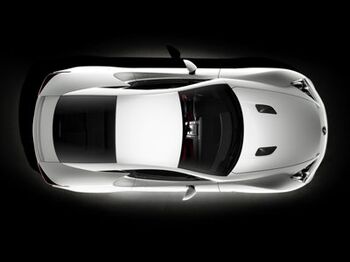
Overview[]
Engine[]
The Lexus LFA is powered by a 72-degree bank angle 4,805 cc (4.8 L; 293.2 cu in) V10 engine equipped with Dual VVT-i carrying the 1LR-GUE designation with a maximum output of 412 kW (560 PS; 553 hp) delivered at 8,700 rpm. Its maximum torque output of 480 N⋅m (354 lb⋅ft) arrives at 6,800 rpm, 90 percent of which is available from 3,700 rpm. The engine redlines at 9,000 rpm, but with a fuel cutoff set at 9,500 rpm, and is constructed using forged aluminum pistons, forged titanium connecting rods, and solid titanium valves. The V-angle of the LFA's V-10 engine is set to 72-degrees to fully balance the firing force from the pistons. This 72-degree angle allows for even firing from the pistons without the use of a split-journal crankshaft, thus improving engine efficiency as well as lowering the overall weight. Dry sump lubrication prevents engine oil starvation through high-speed corners and lowers the engine's center of mass. Air is fed directly from beneath the hood through a visible slit passing into a dual-stage variable intake manifold and then into ten individual throttle bodies before finally exiting from a dual-stage titanium muffler.
The LFA's engineers selected a V10 engine over an equivalent displacement V8 engine for its ability to rev higher, and over a V12 for its lower reciprocating mass, allowing for more rapid engine response. Lexus claimed their engine could rev from idle to its redline in 0.6 seconds and an analog tachometer needle could not accurately track the LFA's changes in engine speeds. This necessitated the use of a digital tachometer which can instantly display engine speed. The engine reportedly weighs less than the manufacturer's own 3.5-litre 2GR-FE V6 engine. Engineers attempted to make the engine sound like that of a Formula One car with high revs, while at the same time maintaining reliability and vibration control. Along with other manufacturers such as Ferrari, Toyota had produced its own F1 engines and chassis designs. The exhaust note has been described by Toyota engineers as the "roar of an angel", and a US television spot later used the engine sound to shatter a champagne glass via resonance frequency.
The powerplant gives the LFA a weight-to-power ratio of 2.67 kg/hp and enables it to reach a top speed of around 325 km/h (202 mph). Unlike the IS F's 2UR-GSE engine, Yamaha co-developed the entire engine, and not just the cylinder heads. The engine exceeds Euro V emissions. The engine is installed with a front mid-engine placement. According to Chief Engineer Haruhiko Tanahashi a front engine layout was selected instead of a mid engine layout as it is inherently more forgiving dynamically, affording less experienced drivers a wider safety net.
Transmission[]
The gearbox built by Aisin is a six-speed single-clutch automated manual transmission actuated with paddle-shifters. Lexus initially sought to use a dual-clutch transmission, but decided that the shift feel was too smooth. Instead, they opted for an automated sequential gearbox, a system previously developed for the Toyota MR2 by Norwegian technology company Kongsberg Devotek (now Semcon). While much of the software and control system was kept, Devotek adapted the mechanics and hydraulics of to match the increased performance demands of the LFA.
Chassis[]
The Lexus LFA's frame is made from an in-house designed and manufactured carbon fibre-reinforced polymer (CFRP) centre monocoque with aluminium front and rear subframes. The subframes, which can be removed and replaced minimising potential repair costs, are joined to the monocoque using a newly developed aluminum flanged collar designed to create a stronger joint. According to the manufacturer, the quality of the CFRP material matches that of aeronautical grades and is woven by a laser monitored circular loom, one of only two in the world. Overall 65% of the vehicle's total body mass is CFRP material while the remaining 35% is aluminum. Manufacturer data indicates that the use of CFRP saves 100 kg (220 lb) over equivalent aluminum materials.
An electric power steering rack with a 14.3:1 gear ratio is used. The front suspension utilises a double-wishbone arrangement and there is a multi-link arrangement at the rear with coil-over dampers at all wheels. The dampers are a monotube design, each with a remote fluid reservoir that includes an expanding and contracting bellows: a purely mechanical system. The LFA further features six-piston front and four-piston rear Brembo monobloc brake calipers with 390 mm (15.4 in) front and 360 mm (14.2 in) rear carbon ceramic discs controlled by Toyota's Electronically Controlled Brake-by-wire system. Forged 20-inch BBS wheels fitted with 265 mm (10.4 in) front and 305 mm (12.0 in) rear Bridgestone next-generation Potenza tyres are standard. The LFA is equipped with a three-mode Vehicle Dynamics Integrated Management (VDIM) stability control system with Sport setting.
To maintain a near-ideal weight distribution, a rear transaxle is used, in addition to the mounting of the fuel tank ahead of the rear axle and the radiators at the rear. The windshield washer fluid reservoir is mounted in the center next to the fuel tank to improve further the center of weight. Overall 48% of the LFA's mass is distributed along with the front wheels with 52% at the rear. The 73 L (16 imp gal; 19 US gal) fuel tank straddles the exhaust system keeping weight centered along the left-right axis. The engine is connected to the transaxle via a rigid carbon-fibre torque tube which the exhaust system runs directly below.[4] This stacked driveshaft and exhaust arrangement decreases the width of the centre tunnel allowing for centrally located seating.
Exterior[]
The LFA has an overall length of 4,506 mm (177.4 in), while its wheelbase measures 2,606 mm (102.6 in), with a height of 1,219 mm (48 in) and width of 1,895 mm (74.6 in). Compared to the prior 2007–2008 concepts, the production model is nearly 51 mm (2 in) longer, with identical width, height, and nearly same wheelbase dimensions. The exterior design of the LF-A concepts and the final production model was the work of car stylists led by Lexus Design general manager Kengo Matsumoto. The overall design ethos was based on the principle of form follows function, with aesthetics secondary to aerodynamics and operation.
The LFA's body features sharp edges and cutoffs for improved aerodynamic performance, made possible by the carbon fiber body. The body was designed with an emphasis on downforce. There are air scoops located over the rear fenders which feed the aft-mounted radiators and help cool the brakes. A horizontal hood gap also feeds air to the engine. Two small aft vents expel air that is collected by an underbody air scoop and used to cool the titanium exhaust pipes. Dual hood ducts serve to move hot air away from the exhaust manifold.
The LFA's speed-sensitive rear wing incorporates a Gurney flap and deploys at speeds over 80 km/h (50 mph). With the wing retracted the LFA's body has a drag coefficient of Cd=0.31. The LFA body was offered with a choice of 28 standard exterior colours, along with 3 wheel colours and a matte black option. Additional special colours are available to order. The front and rear fenders, doors, roof rails, and rocker panels are made out of blast fiber reinforced sheet panels, while the tail lamps are light-emitting diode (LED) lights.
Nürburgring package[]
On 15 March 2010, Lexus detailed the circuit-tuned variant of the LFA, plans for which were first disclosed at the LFA official press launch the previous October. The variant is officially known as the LFA Nürburgring Package in reference to the similar setup employed on the LFA race cars at the 24 Hours Nürburgring.
The package features an extra 7.4 kW (10 PS; 10 hp) from its V10 engine, bringing the total to 420 kW (571 PS; 563 hp). It also features a re-calibrated transmission with gear shifts made faster by 0.05 seconds, a front splitter, stiffer and more adjustable suspension, lightweight alloy wheels wrapped in high performance street tyres, aerodynamic canards at the sides of the front bumper, and a large fixed rear wing.
The LFA with the Nürburgring Package is a competition-focused variant and was available in four exterior colours, namely glossy black, matte black, race yellow, and whitest white. The production totals are to be included in the 500-unit total LFA planned build cycle, and although Lexus stated it would be limited to a 50-unit run, a total of 64 were produced. Buyers received training sessions at the Nordschleife, accompanied by Nürburgring chief instructors, a one-night stay at the Lindner Congress and Motorsport Hotel Nürburgring, admission to the ring°werk leisure park, a Nürburgring branded jacket, and a one-year pass to the circuit.
The Nürburgring Package LFA was tested at the Nürburgring in June 2011. Driven by Akira Iida, the LFA set a time of 7:22.85 (video confirmed), the 7th-fastest time ever for a road-legal production vehicle. Lexus confirmed that this lap video was recorded as a "warm-up" video for the "ADAC 24-hours" for exhibition purposes. The LFA hit 292 km/h (181 mph) on the last straight uphill climb, which is one of the highest speeds achieved by factory standard sports car on that segment of the track. Standard OEM Bridgestone Potenza RE70 performance street tyres were used.
On 2 September 2011 reports came from Lexus via Twitter as well as Chris Harris of Evo Magazine that the Lexus LFA Nürburgring Package completed a lap of the Nürburgring in 7:14.64 with a top speed of 298 km/h (185 mph) on the "Döttinger" uphill climb, making it the fastest road-legal production vehicle to lap the racetrack at the time. A few days later, the time was confirmed by Lexus as 7:14.64 and a video was provided. OEM Bridgestone Potenza RE070 street tyres had been used to set the record.
Worldwide[]
If the vehicle is sold in other markets worldwide, then this is the section to mention that information. Also, mention if the <MODEL> goes by another name in these other markets.
Lexus LFA in Pop Culture[]
- The Lexus LFA is included in “Stig's Garage Car Pack”, a downloadable trio of cars available only to Forza Motorsport 3 Ultimate Collection.
- The LFA is a drivable vehicle in Forza Motorsport 4 and GranTurismo 5.
- Aside from Grand Turismo and Forza Motorsport games, the LFA is also featured in Need For Speed games.
Awards[]
List out notable awards that the model has received while in production. Boldface the company or organization that gives out the award, and Italicize the name of the award.
See Also[]
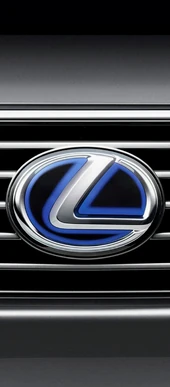
| ||
| LEXUS | ||
|
Toyota | Lexus | Scion | Hino | Daihatsu Current Cars: IS 250/250C/350 · IS-F · ES 350 · GS 300/430/450h · LS 460/460L · LS 600h/600hL · LFA · CT 200h SUVs: RX 330/350/400h · GX 460 · LX 470 · LX 570 Hybrid: RX 450h · GS 450h · LS 600h/600hL · HS 250h Historic Cars: IS 200/300 · ES 250/300/330 · GS 300/400/430 · LS 400/430 · SC 300/400/430 Hybrid: RX 400h Racing Vehicles Concept Vehicles LF-A Concept · LF-C Concept · LF-Ch Concept · LF-S Concept · LF-Sh Concept · LF-X Concept · LF-Xh Concept · IS 250 Sports Concept Engines · Transmissions · Lexus F | ||
| Toyota | Corporate website | A division of the Toyota Motor Corporation |
References[]
- ↑ Official production release site
- ↑ "Toyota Registers "LFA" Trademark, Lexus Supercar One Step Closer To Production". The Motor Report. 2008-12-17. http://www.themotorreport.com.au/15081/lexus-lf-a-one-step-closer-to-production/. Retrieved 2009-10-20.
- ↑ 3.0 3.1 "Lexus LF-A - Road Test First Drive". Autocar. http://www.autocar.co.uk/CarReviews/FirstDrives/Lexus-LF-A-5.0/241363/. Retrieved 2009-09-02.
- ↑ "Technical Analysis: 2011 Lexus LFA (12/2009)". Road & Track Magazine. http://www.roadandtrack.com/article.asp?section_id=10&article_id=8479. Retrieved 2009-10-22.
- ↑ "Lexus LFA Officially Debuts, “Special Model” Due In 2012". The Motor Report. http://www.themotorreport.com.au/44916/lexus-lfa-officially-debuts-special-model-due-in2012-video/. Retrieved 2009-10-22.
- ↑ http://www.autoexpress.co.uk/news/autoexpressnews/215355/lexus_lfa.html
- ↑ http://www.roadandtrack.com/article.asp?section_id=7&article_id=8480
- ↑ Lexus Unveils LF-A Concept at 2005 NAIAS
- ↑ http://www.roadandtrack.com/article.asp?section_id=10&article_id=8479
- ↑ Official LFA press information
- ↑ Lexus LFA top speed & performance figures
External Links[]
News and References
- VIDEO: Lexus LF-A breaks cover before Tokyo unveiling
- Full Production Lexus LF-A Caught Inside & Out Ahead of Tokyo Unveiling
- Tokyo 2009: Lexus reveals $375,000 LFA supercar...finally
- Lexus LF-A: Production Version of V10 Supercar Uncovered in Photos and Video
- VIDEO: Lexus LFA Official Promo Film with Some Track Action
- 2012 Lexus LFA: Official High-Res Photos and Specs of Ferrari-Fighting Supercar, Priced at $375,000
- Lexus LFA Officially Unveiled in Tokyo
- One more massive Lexus LF-A leak, with specs
- Lexus LFA Online Configurator Launched, and yes, 'Passionate Pink' is Offered on the Menu...
- Lexus Hangs CAD-Like Wire-frame LFA Cut-Away On Wall Like Trophy
- Lexus LFA All-Digital Tach, Speedo: First Look
- Tokyo 2009: Cool As Ice: Japanese architect builds full-size transparent Lexus LFA
- REPORT: Lexus to lease - not sell - all 500 LFA supercars in order to foil speculators
- Lexus LFA to be sold in Europe through one dealership
- Officially Official: 2012 Lexus LFA priced at $375,000*
- Lexus LFA Special Edition Officially Revealed - As if this NEEDED to Happen...
- Lexus Heading Back to 24h of Nürburgring with LFA Supercar - First Photos
- Lexus Announces LFA Luggage Collection, Tens of Buyers Rejoice
- 2012 Lexus LFA
- Lexus LFA Nurburgring Edition: review
- Lexus documents LFA development
Enthusiast Sites and Discussion Forums

